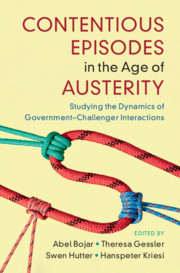 Contentious Episodes in the Age of Austerity
Contentious Episodes in the Age of Austerity Book contents
- Contentious Episodes in the Age of Austerity
- Cambridge Studies in Contentious Politics
- Contentious Episodes in the Age of Austerity
- Copyright page
- Contents
- Figures
- Tables
- Contributors
- Preface
- Part I A New Approach to the Analysis of Contentious Episodes
- 1 Introduction
- 2 Selecting and Coding Contentious Episodes
- 3 The Economic and Political Contexts of the Episodes
- Part II Varieties of Contention
- Part III Dynamics of Interaction
- Part IV Conclusion
- Appendices
- References
- Index
- Series page
1 - Introduction
A New Approach for Studying Political Contention – Contentious Episode Analysis
from Part I - A New Approach to the Analysis of Contentious Episodes
Published online by Cambridge University Press: 05 November 2021
- Contentious Episodes in the Age of Austerity
- Cambridge Studies in Contentious Politics
- Contentious Episodes in the Age of Austerity
- Copyright page
- Contents
- Figures
- Tables
- Contributors
- Preface
- Part I A New Approach to the Analysis of Contentious Episodes
- 1 Introduction
- 2 Selecting and Coding Contentious Episodes
- 3 The Economic and Political Contexts of the Episodes
- Part II Varieties of Contention
- Part III Dynamics of Interaction
- Part IV Conclusion
- Appendices
- References
- Index
- Series page
Summary
On 24 May 2011, in the middle of the parliamentary debate on the so-called mid-term adjustment plan, yet another round of austerity imposed by Greece’s international creditors, a call for a demonstration at Syntagma Square in Athens and at the White Tower in Thessaloniki appeared on Facebook. By the next day at least 20,000 people assembled in the two squares, mostly chanting “thieves, thieves” at parliamentarians and cursing the Parliament. The movement of the Greek Indignados or Aganaktismenoi was born. It would prove to be massive, expansive, and innovative. Immediately after the initial demonstrations, the main squares in the two cities were occupied, and simultaneous protests began in almost all major urban centers of the country. Interest would focus on Syntagma Square, however, where the occupation was symbolically confronting Parliament, juxtaposing the public assembly and the symbolic seat of political power. In the following days, the occupation grew exponentially, eventually reaching almost 400,000 participants on June 5th. In our dataset, there is an event associated with the Aganaktismenoi on almost every single day until the end of the episode on June 30th.
- Type
- Chapter
- Information
- Contentious Episodes in the Age of AusterityStudying the Dynamics of Government–Challenger Interactions, pp. 3 - 23Publisher: Cambridge University PressPrint publication year: 2021
- 1
- Cited by


